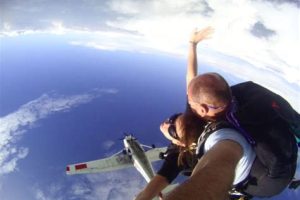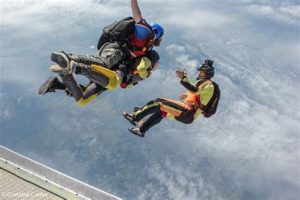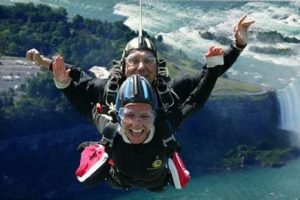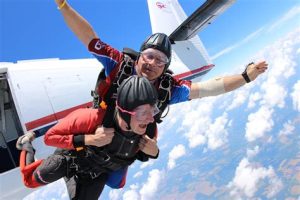Table of Contents
Tandem skydiving is an exhilarating experience that comes with risks. Unfortunately, accidents can occur, leading to tragic outcomes such as death. Discover the reality of tandem skydiving fatalities and the importance of safety measures in this heart-wrenching exploration.
Tandem skydiving, a thrilling activity that promises an adrenaline rush like no other, can unfortunately turn into a tragedy in the blink of an eye. As the wind whistles past your ears and your heart pounds in your chest, the unimaginable becomes a grim reality for some daredevils. With one wrong move or unexpected twist of fate, a tandem skydiving experience can quickly escalate into a fatal event that leaves loved ones grieving and the skydiving community shaken to its core. In this article, we will explore the devastating consequences that can arise from the seemingly exhilarating world of tandem skydiving.
Introduction
Tandem skydiving is a thrilling and adrenaline-pumping activity that attracts adventure enthusiasts from all walks of life. However, as with any extreme sport, there are inherent risks involved. Tragically, there have been instances where tandem skydiving has resulted in fatalities. In this article, we will explore the unfortunate reality of tandem skydiving deaths, highlighting the importance of safety precautions and proper training.
The Statistics
Understanding the Numbers
While tandem skydiving deaths are relatively rare, it is crucial to acknowledge their occurrence and take appropriate measures to minimize the risks involved. According to recent statistics, approximately one in every 500,000 tandem skydives results in a fatality. Although the chances of a tragic outcome are statistically low, each incident serves as a stark reminder of the importance of safety protocols and thorough training.
Causes of Tandem Skydiving Deaths
Equipment Malfunctions
One of the primary causes of tandem skydiving deaths is equipment malfunctions. Parachute failures, harness issues, or problems with the reserve chute can lead to disastrous consequences. Regular maintenance and rigorous inspections are essential to minimize the risks associated with faulty equipment.
Human Error
In some unfortunate cases, tandem skydiving deaths occur due to human error. This can include improper body positioning during freefall, incorrect deployment of the parachute, or misjudgment of altitude. Comprehensive training and adherence to safety protocols are crucial in preventing such incidents.
The Importance of Proper Training
Choosing a Reputable Training Facility
Before embarking on a tandem skydiving experience, it is essential to select a reputable training facility. Ensure that the instructors are certified and have extensive experience in the field. Thoroughly research the facility’s safety record and read reviews from previous participants.
Understanding Safety Procedures
Proper training equips participants with the knowledge and skills necessary to handle various scenarios that may arise during a tandem skydive. Understanding safety procedures, emergency protocols, and proper body position during freefall are crucial aspects of a comprehensive training program.
Practice Makes Perfect
Training should also include practical sessions where participants can practice deploying their parachutes and perform emergency procedures in a controlled environment. Frequent practice instills muscle memory, ensuring that participants can react quickly and appropriately in case of an emergency.
Minimizing the Risks
Strict Adherence to Safety Guidelines
To minimize the risks associated with tandem skydiving, strict adherence to safety guidelines and protocols is paramount. This includes wearing appropriate safety gear, double-checking equipment before each jump, and following instructions from experienced instructors without deviation.
Regular Equipment Inspections
Regular equipment inspections and maintenance by certified professionals are essential to ensure the reliability of parachutes, harnesses, and other gear. This helps identify any potential issues before they become life-threatening problems.
Conclusion
While tandem skydiving deaths are tragic reminders of the inherent risks associated with this extreme sport, it is crucial to remember that with proper training, adherence to safety protocols, and regular equipment maintenance, the risks can be significantly mitigated. Tandem skydiving can continue to be an exhilarating and safe adventure for thrill-seekers worldwide if approached with caution and respect for safety measures.
Pre-flight Preparation
Before embarking on a tandem skydiving experience, ensuring the proper safety equipment is crucial. Take the time to carefully check and confirm that you have all the necessary gear, including a well-fitted harness, helmet, and goggles. Each piece of equipment should be in good condition and free from any defects or damage. Properly fitting gear is essential to ensure your safety during the jump, so make sure everything is securely fastened and adjusted to your body.
Instructor Communication
Effective communication with your skydiving instructor is paramount to a safe and successful tandem skydiving experience. Before the jump, take the opportunity to establish a clear line of communication with your instructor. Discuss and clarify any questions or concerns you may have regarding the safety protocols and procedures. It is essential to understand and follow the instructions given by your instructor throughout the entire process to maintain a safe environment for everyone involved.
Weather Assessment
Checking and verifying the weather conditions before proceeding with a tandem skydiving jump is of utmost importance. Weather conditions play a significant role in the safety of the activity. Adverse weather, such as strong winds, thunderstorms, or low cloud cover, can pose serious risks during a jump. Always consult with your instructor and rely on their expertise to determine if the weather conditions are suitable for skydiving. It is better to reschedule the jump than to risk compromising safety due to unfavorable weather conditions.
Training and Instruction
Prior to participating in tandem skydiving, it is essential to receive thorough training and instruction from a certified skydiving instructor. Your instructor will guide you through the proper techniques and safety procedures, ensuring that you have a comprehensive understanding of what to expect during the jump. Pay close attention to the instructions provided and ask any necessary questions to clarify any uncertainties. Following proper training and instruction significantly minimizes the risk of accidents or incidents during the jump.
Safety Precautions
Before taking the leap, it is crucial to double-check all equipment to ensure its proper functioning. Perform a thorough inspection of the harness, parachute, and any other gear involved in the tandem skydiving experience. Check for any signs of wear and tear, loose fittings, or malfunctions. Any faulty equipment should be immediately replaced or repaired before proceeding with the jump. Remember, the safety of your equipment directly affects your overall safety during the jump.
Emergency Procedures
Emergencies can happen unexpectedly, and it is essential to be prepared. Familiarize yourself with the emergency procedures and protocols provided by your instructor. Pay close attention to parachute deployment techniques and landing procedures. Communicate openly with your instructor about any concerns you may have and ensure that you are confident in handling unexpected situations. Being prepared and knowledgeable about emergency procedures will help you stay calm and make informed decisions if the need arises.
Physical Fitness and Health Evaluation
Prior to participating in tandem skydiving, it is advisable to undergo a thorough physical fitness evaluation. Skydiving can be physically demanding, and being in good health is essential. Consult with a healthcare professional to ensure you have no underlying medical conditions that may pose a risk during the activity. Your safety and well-being should always be the top priority.
Risk Awareness and Acknowledgement
Before embarking on a tandem skydiving experience, it is crucial to fully understand and acknowledge the inherent risks associated with the activity. Carefully read and sign all necessary legal documents, which typically include a liability waiver and consent form. These documents inform you of the potential dangers involved and require you to assume personal responsibility for any potential outcomes. By signing these documents, you acknowledge that you have been informed of the risks and voluntarily choose to participate in tandem skydiving.
Note:
While skydiving is generally safe, accidents and incidents can occur. It is vital to follow all safety instructions provided by your instructor and maintain a responsible attitude towards your personal safety at all times during the tandem skydiving experience. Remember that your instructor is there to guide and assist you throughout the jump, so trust their expertise and enjoy the exhilarating adventure with confidence.
In my point of view, the topic of tandem skydiving deaths is a serious matter that requires clear instructions and a cautious tone to address. Below are some key points to consider:
1. Provide detailed instructions:
- Clearly outline the necessary steps and safety precautions involved in tandem skydiving.
- Include information about the equipment, how it works, and how to properly use it.
- Highlight the importance of following all instructions provided by the instructor.
- Mention any specific requirements or restrictions for participants, such as age or health conditions.
2. Emphasize safety measures:
- Clearly state that safety is the top priority and that all precautions are taken to minimize risks.
- Explain the rigorous training and certification process instructors undergo to ensure their competence.
- Highlight the safety features of the equipment used, such as the automatic activation device (AAD) on the parachute.
- Encourage participants to ask questions and express any concerns they may have about safety.
3. Use a cautious and informative tone:
- Avoid using overly casual or lighthearted language that might undermine the seriousness of the activity.
- Be factual and informative, providing accurate details without exaggerating or downplaying any risks.
- Address any potential fears or anxieties participants may have and reassure them of the extensive safety measures in place.
- Remind participants to listen carefully to their instructor and follow their guidance throughout the experience.
4. Include disclaimers and legal information:
- Add a disclaimer stating that while all precautions are taken, there is still an inherent risk associated with skydiving.
- Inform participants about any necessary waivers or legal documents they need to sign before participating.
- Provide contact information and resources for participants to seek further information or clarification.
By following these guidelines, the instructions can effectively convey the importance of safety while ensuring participants are well-informed and prepared for their tandem skydiving experience.
Thank you for taking the time to read this article about tandem skydiving death. We understand that discussing such a tragic event can be difficult, but it is important to shed light on these incidents to raise awareness and promote safety in the sport.
Firstly, we would like to express our deepest condolences to the family and friends of the individual who lost their life in this unfortunate incident. Our thoughts are with you during this difficult time. Losing a loved one is never easy, and we can only hope that you find strength and support to navigate through this challenging period.
It is crucial to note that tandem skydiving is generally considered a safe activity when proper precautions are taken. However, accidents can still occur, and it is vital to understand the risks involved before participating. Safety measures such as thorough training, regular equipment maintenance, and adherence to established protocols are all key factors in minimizing the likelihood of accidents.
In light of this incident, we urge both experienced skydivers and beginners alike to prioritize safety above all else. For those considering tandem skydiving, we highly recommend researching reputable skydiving centers that have a proven track record of safety and professionalism. Don’t hesitate to ask questions about the qualifications and experience of the instructors, the maintenance procedures for the equipment, and the safety protocols in place.
Furthermore, it is essential to listen carefully during the pre-jump briefing and follow all instructions provided by your instructor. They are there to ensure your safety and guide you through the entire experience. Remember, tandem skydiving is a team effort, and open communication between you and your instructor is paramount.
Lastly, if you ever feel uncomfortable or uncertain about any aspect of the jump, do not hesitate to voice your concerns. Your safety should always be the top priority, and a reputable skydiving center will address any doubts or worries you may have. It is better to postpone the jump or find an alternative solution rather than proceeding with something that doesn’t feel right.
In conclusion, tandem skydiving can be an exhilarating and unforgettable experience when approached with caution and proper preparation. However, it is crucial to acknowledge the risks involved and prioritize safety at all times. Our hearts go out to the family and loved ones affected by this tragic incident, and we hope that by raising awareness, we can help prevent future accidents and ensure the well-being of all skydivers.
Video Tandem Skydiving Death
People also ask about Tandem Skydiving Death:
- How common are deaths in tandem skydiving?
- What are the main causes of tandem skydiving deaths?
- Can you survive a tandem skydiving accident?
- What precautions can be taken to minimize the risk of tandem skydiving accidents?
- Is tandem skydiving safer than solo skydiving?
Tandem skydiving is generally considered to be safe, with a very low risk of fatalities. According to the United States Parachute Association (USPA), the fatality rate for tandem skydiving is approximately 0.003 per 1,000 jumps. While accidents can happen, they are extremely rare.
The main causes of tandem skydiving deaths are typically related to human error or equipment failure. Human error can include improper body position during freefall, inadequate training, or failure to follow proper procedures. Equipment failure can involve parachute malfunctions or issues with the harness system. It is important to note that these incidents are highly uncommon and strict safety protocols are in place to minimize risks.
While surviving a tandem skydiving accident is possible, it largely depends on the nature of the incident and various factors such as altitude, parachute deployment, and the extent of any injuries sustained. In most cases, both the instructor and passenger are equipped with backup parachutes, increasing the chances of survival in case of a primary parachute malfunction. Furthermore, tandem skydiving instructors undergo extensive training to handle emergency situations and ensure the safety of their passengers.
To minimize the risk of tandem skydiving accidents, it is crucial to choose a reputable skydiving center that follows stringent safety protocols. Prior to the jump, thorough training and instruction should be provided to both instructors and passengers. It’s important to communicate any concerns or medical conditions to the instructor beforehand. Additionally, regular maintenance and inspection of equipment should be conducted to ensure its reliability.
Tandem skydiving is generally considered safer than solo skydiving, as the passenger is attached to a highly trained instructor who takes care of all the technical aspects of the jump. The instructor is responsible for deploying the parachute and ensuring a safe landing. In solo skydiving, individuals must undergo extensive training and demonstrate proficiency in various skills before jumping alone. Both tandem and solo skydiving involve inherent risks, but tandem skydiving provides an added layer of safety through instructor guidance.






